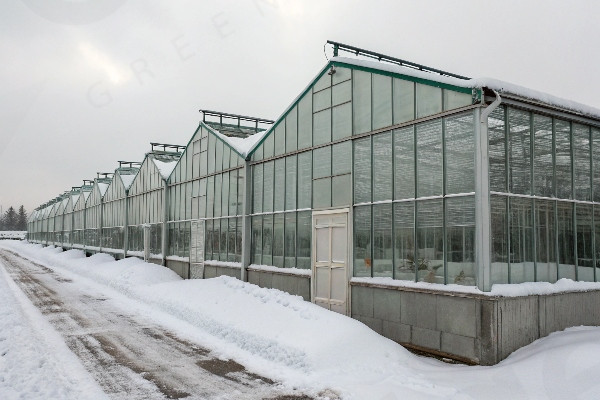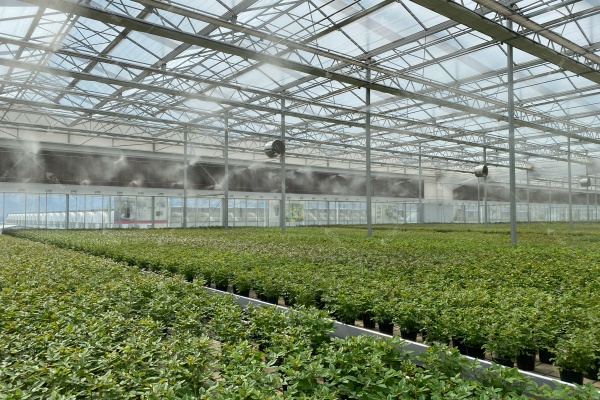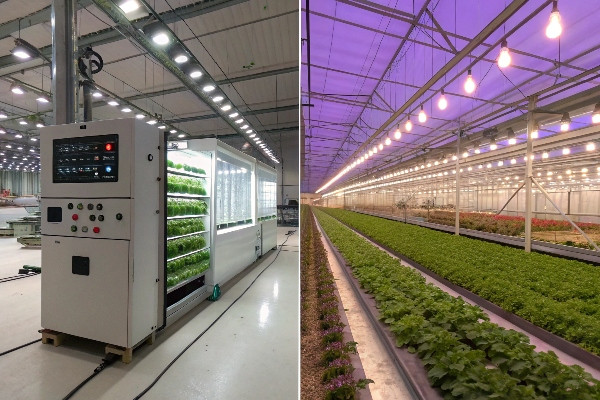Growing blueberries outdoors exposes crops to unpredictable weather, pests, and limited growing seasons. Many farmers struggle with inconsistent yields and quality, wondering if there’s a better approach.
Commercial greenhouse blueberry cultivation has proven highly viable, offering returns faster than most protected crops. Plants can produce fruit within just one year and maintain impressive 3-4 month harvest periods, making them exceptionally profitable when growing conditions are optimized through proper greenhouse systems.
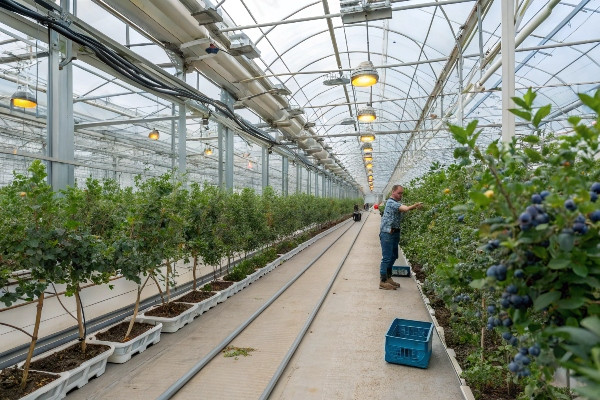
In my 28 years working with greenhouse systems at CFGET, I’ve helped countless growers transition various crops to controlled environments. Blueberries stand out for their economic potential when grown under the right conditions. Let me share what makes greenhouse blueberry cultivation a smart investment worth your consideration.
Don’t Miss:——Exploring Greenhouse Types: Finding the Perfect Structure for Your Needs
You might like:——Mastering Strawberry Greenhouse Cultivation: Best Practices for Optimal Growth?
Comparing Greenhouse vs. Field Production for Blueberries?
Field-grown blueberries face constant threats from frost damage, extreme weather, and pest invasions. These problems can destroy an entire season’s harvest and create financial hardships lasting several years.
Greenhouse production offers major advantages over field cultivation including longer growing seasons, protection from weather extremes, and consistently higher quality fruit. The controlled environment allows faster development and reliable harvests regardless of outside conditions.
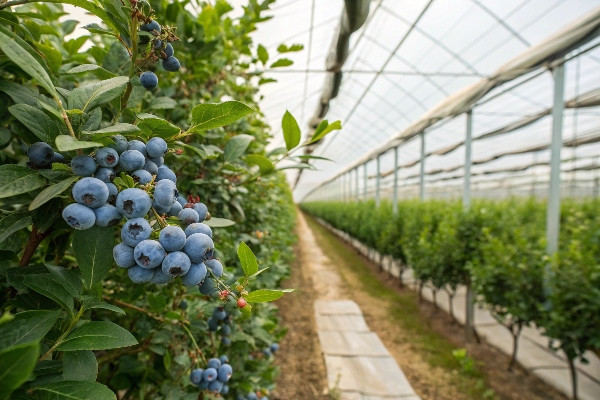
Last year, I visited a client in Vietnam who switched from traditional field growing to greenhouse production. The results were eye-opening. Their field-grown bushes needed 3-4 years to reach full production, while greenhouse plants produced marketable crops within just 12 months. This dramatic time reduction creates huge financial benefits.
Greenhouse environments give growers precise control over key factors that directly impact fruit quality and yield. Temperature management prevents cold damage during critical flowering and fruiting stages. In many areas, late spring frosts can destroy an entire field crop, but greenhouse growers don’t face this worry.
Water efficiency is another major advantage. Our greenhouse systems typically use 60-70% less water than field production through targeted irrigation and reduced evaporation. This saves resources and reduces disease problems from excess moisture on leaves.
Growth Rate and Production Timing
The controlled climate in greenhouses speeds up plant development cycles. Field-grown blueberries often stop growing during cold periods or slow down in poor conditions. Greenhouse environments maintain ideal growing conditions year-round, resulting in faster plant establishment and earlier fruit production.
When we compare production schedules, the differences become clear:
| Production Aspect | Field Cultivation | Greenhouse Cultivation |
|---|---|---|
| Time to first harvest | 2-3 years | 8-12 months |
| Annual harvest window | 4-6 weeks | 12-16 weeks |
| Seasonal limitations | Yes (weather dependent) | Minimal |
| Yield per plant | 2-4 kg | 4-6 kg |
| Fruit quality uniformity | Variable | Consistent |
The extended harvest window brings special value for commercial operations. While field-grown berries flood the market during a short season, greenhouse production can be planned for maximum market advantage. The ability to produce during off-peak times often results in premium pricing and stronger relationships with buyers who want consistent supply throughout the year.
Optimizing Greenhouse Systems for Large-Scale Blueberry Cultivation?
Many greenhouse systems designed for vegetables or flowers fail completely when used for blueberries. These failures cause poor yields, disease outbreaks, and financial disappointment for growers who don’t understand the specific needs of this crop.
Successful large-scale blueberry greenhouse cultivation requires specialized environmental controls that maintain proper humidity, temperature differences between day and night, and correct substrate pH. The best systems focus on maximizing light while providing enough cooling and airflow for consistent fruit production.
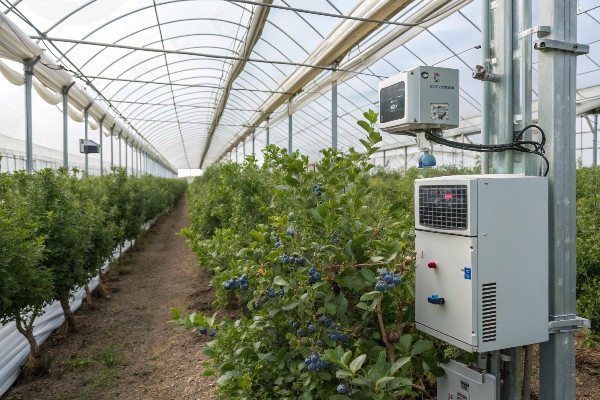
When I first started working with blueberry greenhouse projects, I quickly learned that this crop has unique requirements compared to standard greenhouse plants. The main difference is their need for specific growing media pH and particular light conditions. Blueberries need acidic soils with pH between 4.5 and 5.2, which is much lower than most greenhouse crops.
For commercial operations, I recommend substrate-based systems rather than soil-based growing. Using coconut coir or peat-based substrates with proper acidification allows precise nutrition control and lowers disease risks. We implemented this approach for a major producer in Thailand, increasing their yields by 35% compared to their previous floor-based growing method.
Lighting plays a crucial role in optimization. Blueberries need strong light but can suffer leaf burn under too much direct exposure. In our greenhouse designs, we typically use diffused light technology that spreads light evenly through the plant canopy. This prevents "hot spots" and ensures all parts of the plant receive enough light for photosynthesis. For regions with insufficient natural light, adding LED lighting with specific blue and red light spectrums has shown excellent results in maintaining production during darker periods.
Climate Control Considerations
Temperature management is especially important for blueberry production. Keeping day temperatures between 20-25°C (68-77°F) and night temperatures between 10-15°C (50-59°F) creates the ideal environment for both vegetative growth and fruit development. This day-night temperature difference triggers proper hormonal responses in the plants.
Humidity control is another critical factor. Our systems include these elements:
| Climate Factor | Optimal Range | Control Method |
|---|---|---|
| Day Temperature | 20-25°C (68-77°F) | Ventilation, cooling pads, shade screens |
| Night Temperature | 10-15°C (50-59°F) | Heating systems, thermal screens |
| Relative Humidity | 60-75% | Dehumidifiers, ventilation control |
| CO₂ Levels | 800-1000 ppm | CO₂ enrichment systems |
| Air Movement | Constant gentle flow | Horizontal airflow fans |
When implementing these systems for a major production facility in Malaysia, we found that maintaining proper vertical air circulation prevented powdery mildew development, a common problem in humid greenhouse environments. The investment in advanced climate controls paid for itself within the first production cycle through disease prevention alone.
Investment Considerations: Costs and ROI for Blueberry Greenhouses?
The initial greenhouse setup costs often seem overwhelming, causing many potential growers to give up on the idea. This hesitation means missing out on the rapid returns that blueberry greenhouse production can deliver to smart investors.
Greenhouse blueberry cultivation requires substantial upfront investment but offers faster ROI than most greenhouse crops. Initial costs range from $25-45 per square meter for basic structures to $200-350 for fully automated systems, with most commercial operations achieving profitability within 2-3 years.
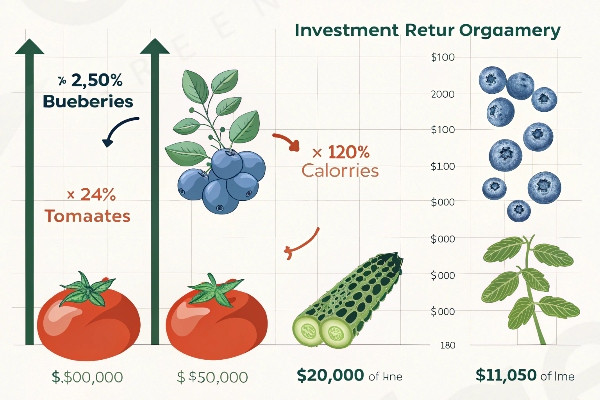
When clients ask me about greenhouse investments, their first question is always about costs. I’m direct about this: quality greenhouse systems for blueberries require significant capital. However, what makes blueberries unique is their relatively quick path to profitability compared to woody perennials like tree fruits.
Based on our projects across Southeast Asia and Europe, I’ve seen that investment returns depend heavily on several factors: local climate, market access, and level of automation. In tropical regions, simpler structures can work well, while cold climates need more sophisticated (and expensive) climate control systems.
The cost breakdown typically follows this pattern:
| Component | Percentage of Total Investment | Notes |
|---|---|---|
| Greenhouse structure | 35-40% | Varies by climate requirements |
| Environmental control systems | 20-25% | Heating, cooling, ventilation |
| Growing system | 15-20% | Containers, substrate, irrigation |
| Plants | 10-15% | Variety selection impacts costs |
| Labor systems | 5-10% | Automation, harvesting efficiency |
I worked with a medium-sized operation in Eastern Europe that invested approximately $650,000 in a 1-hectare greenhouse system optimized for blueberries. Their initial harvest, just 10 months after planting, yielded 12 metric tons of high-quality fruit. By the second year, production increased to 22 tons, and by year three, they reached their target of 30 tons per hectare.
Financial Projections and Considerations
The most successful operations I’ve helped develop share one characteristic: they target premium markets rather than competing with field-grown commodity fruit. Greenhouse-grown blueberries command higher prices due to their size, flavor, and availability during off-seasons.
A realistic financial projection for a well-managed 1-hectare operation might look like this:
| Year | Production (tons) | Estimated Revenue | Operating Costs | Net Income |
|---|---|---|---|---|
| 1 | 8-12 | $120,000-180,000 | $90,000-110,000 | $10,000-70,000 |
| 2 | 18-25 | $270,000-375,000 | $100,000-120,000 | $150,000-275,000 |
| 3+ | 25-35 | $375,000-525,000 | $110,000-130,000 | $245,000-415,000 |
These figures assume premium pricing of $15/kg, which is achievable for high-quality, off-season production. Yields can vary significantly based on variety selection, growing techniques, and management quality. The most important factor I emphasize to clients is that consistent quality management has more impact on profitability than saving on initial infrastructure costs.
Regional climate considerations dramatically affect startup costs. For a client in Yunnan, China, where temperature variations are significant but rainfall is minimal, we designed a basic rain shelter system costing approximately $25 per square meter. In contrast, a client in Northern Europe needed a fully insulated greenhouse with heating systems, pushing costs to over $300 per square meter. Both were profitable, but with different timeframes for investment recovery.
Pollination Strategies for Blueberries in Controlled Environments?
Poor pollination leads to small, misshapen fruits and dramatically reduced yields. This common problem in greenhouse blueberry production can decrease profitability by 40-60% if not properly addressed.
Successful greenhouse blueberry pollination requires integrated approaches including introduced pollinators, mechanical vibration systems, and variety selection for self-fertility. Maintaining optimal temperature and humidity during flowering ensures pollen viability, while proper bee colony management significantly improves fruit set and size.
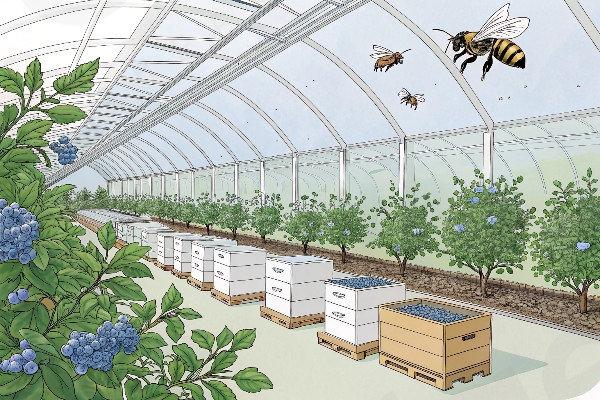
Pollination represents one of the biggest challenges I face when designing blueberry greenhouse systems. Unlike many greenhouse crops that can self-pollinate with minimal help, blueberries require active pollination strategies to achieve commercial yields. The flower structure of blueberries makes them particularly dependent on "buzz pollination," where the flower must be vibrated to release pollen effectively.
After years of testing different methods, I now implement a multi-faceted approach for our clients. The primary solution involves introducing commercial bumble bee (Bombus terrestris) colonies. These bees are much more efficient pollinators for blueberries than honeybees, as they can work in lower light conditions and cooler temperatures, and their larger bodies create better vibration for pollen release.
For a 1000 square meter greenhouse section, we typically introduce 3-4 hives, replacing them every 6-8 weeks during flowering periods. Proper hive placement is crucial—we position them at plant height, protected from direct sunlight and irrigation, with clear flight paths to the flowering plants.
Supplemental Pollination Techniques
While bumblebees provide excellent results, I recommend supplementing their work with additional methods:
| Pollination Method | Effectiveness | Implementation Cost | Labor Requirements |
|---|---|---|---|
| Bumble bee colonies | Very High | Medium | Low |
| Electric vibration wands | Medium-High | Low | High |
| Air movement systems | Low-Medium | Medium | Very Low |
| Hand pollination | High | Very Low | Very High |
| Self-fertile varieties | Medium | Medium | None |
For one of our largest projects in Poland, we implemented a combined approach using bumble bees as the primary pollinators, supplemented with programmed air movement systems that created gentle vibrations during peak pollen release hours (typically mid-morning). This combination increased fruit set by approximately 25% compared to using bees alone.
Variety selection also plays a significant role in pollination success. Modern cultivars like ‘Bluecrop’ and ‘Duke’ tend to have better self-fertility than some traditional varieties. However, even self-fertile varieties benefit from cross-pollination, producing larger fruit with better flavor. I typically recommend planting at least two compatible varieties within each greenhouse to maximize pollination effectiveness.
Climate management during flowering is another critical factor. We maintain temperatures between 18-22°C (64-72°F) during flowering periods, with relative humidity between 60-70%. These conditions optimize both pollen viability and bee activity. Automatic climate control systems monitor these parameters continuously, making small adjustments to maintain ideal pollination conditions throughout the day.
Conclusion
Greenhouse blueberry production represents an excellent investment opportunity with faster returns than most perennial crops. With proper system design, climate management, and pollination strategies, commercial operations can achieve profitability within 2-3 years while producing premium-quality fruit year-round.

